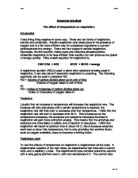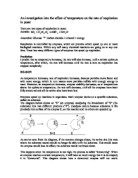The effect of temperature on insect respiration rates
Aim:
To determine how changing the surrounding temperature influences the rate of respiration of an insect, in this case a locust.
Hypothesis:
Increasing the temperature should raise the rate of respiration as it will increase enzyme activity and therefore cell metabolism. This in turn will cause the cells of the locust to use up oxygen more quickly increasing carbon dioxide levels in the cells whose detection will quicken the breathing rate, the observation of the inspiration of air will be used to determine the rate of respiration.
As oxygen is used up, the locust notices this drop by the accumulation of lactic acid in its muscles. When oxygen is not present (anaerobic conditions) the first stage of respiration, glycolysis, and takes place readily but the link reaction in the matrix of the mitochondria is different from that in aerobic respiration. Instead of pyruvate being converted into acetyl coenzyme A, as under aerobic conditions, it is converted to lactic acid. As lactic acid can harm the muscles in large quantities the locust detects a need for greater oxygen consumption, to provide this change the spiracles on the insect's exoskeleton open for longer periods of time and they are moistened to increase the rate of oxygen diffusion into the insect's body. When undertaking activities with high metabolic needs e.g. flying other methods increase the rate of respiration but considering that the locust being used will be at rest these methods will have no effect on the experiments conducted.
Particle theory dictates that increasing the temperature provides kinetic energy to all molecules so causing them to move more quickly so react more often, so enzyme activity increases and the Q10 law states that increasing the temperature by 10ºC should double enzyme activity. Considering that enzyme activity is directly linked to the rate of respiration it can be assumed that increasing the temperature by 10ºC should lead to the doubling of the respiration rate if the Q10 law is to be observed.
Method:
A test tube had some small stones placed in the bottom of it with some cotton wool on top of it, a locust was then placed head down in to the tube. The test tube was placed in a water bath at varying temperatures and the rate of respiration measured at each temperature until a steady value was obtained. The rate of respiration will be measured over one minute periods and will be determined by the number of times the abdomen of the locust moves up and down (the clearest indication of breathing).
The five temperatures used were 10, 20, 30 and 40ºC with the addition of room temperature, which was recorded as 22ºC. The temperatures in all water baths were maintained by occasional heating with a Bunsen flame.








